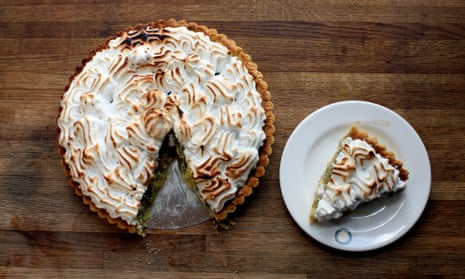Photogenic, trendy meringues – macaroons and pavlovas among them – are spun out of egg whites, sugar and air, and are fundamentally untranslatable to eggless cooking. As a result, vegans, those with food allergies, and other egg rejecters have long missed out on lemon meringue pie, angel kisses and divinity.
This changed on 6 March 2015, when an American software engineer named Goose Wohlt posted a groundbreaking remark to a Facebook group called What Fat Vegans Eat.
The text read: “Dead simple delicious two ingredient whole food meringues … one can chickpea brine mixed w half cup sugar. Perfect-O”. The post was accompanied by pictures of white, puffy meringues.
Wohlt had been searching for the ne plus ultra egg white replacement. Building on French tenor Joël Roessel’s experiments with the molecular gastronomy of bean water, Wohlt discovered that chickpea brine, when whipped, had all the properties of egg whites. He later invented the name “aquafaba” for his discovery, based on the Latin words for “water” and “bean”.
It’s still unclear exactly why it works. Wohlt is raising money for further research on the specific properties of chickpea juice, but other bean brines seem to work as well – I’ve seen reports of kidney and navy beans.
Chickpea fluid has always reminded me of the semi-opaque gunk in which long-dead sea creatures float, dead-eyed, in dusty jars in high school science labs. But I decided to give it a go anyway.
I beat the stuff with an electric hand mixer. It formed stiff peaks. I’ve made French toast, waffles, chocolate mousse, basic white bread, banana muffins and chocolate mousse. It worked. The waffles were the best I have ever eaten. The bread’s crumb was refined.
I did have a few misfires (my fault!) with Miriam Sorrell’s chocolate mousse; I bain-marie’d the chocolate but my timing was off – it cooled down too much by the time I was ready to fold it. But on my second try, I reached the chocolate Goldilocks zone: the perfected chocolate mousse was admirably porous, lofty, and had a luxurious mouthfeel.
Aquafaba is also used for such savory foods as pot pies, eggplant stacks and “egg” noodles. I made some good zucchini fritters with it, and also added aquafaba to my standard tofu crab cakes; it created a subtle bounce and seemed to amplify the umami. I am very much looking forward to making Lacey Siomos’s aquafaba mozzarella, which I think might get me through the winter.
These beautiful macarons are vegan! http://t.co/LliTXB2Ekg #aquafaba pic.twitter.com/Pzp7dFdj5c
— Jasmine Lukuku (@TheBlenderist) September 28, 2015
Aquafaba isn’t limited to recreational experimenting, either. Kitty Soudy, a homemaker living in California, told me that aquafaba has changed the life of her two-year-old granddaughter, who suffers from severe allergies to soy, corn, dairy and some fruits. It was difficult to properly feed her, but Kitty now uses aquafaba to make macaroni and cheese, ice cream, smoothies, cookies, and condiments such as basil mayonnaise for the little girl.
Of course, there’s the question of what to do with all of those chickpeas. I will quite happily eat them out of the can with a fork. Chickpeas can be also tossed into any salad or chilli or curry dish, or baked with olive oil and sprinkled with cumin and salt for a great snack.
In a larger context, chickpeas are one of the cheapest sources of protein available and have an impressive vitamin and mineral profile as well as cancer-fighting properties. The plants tolerate drought conditions and can fix atmospheric nitrogen to soil.
Chickpeas might be indeed be the food of the future. My friend Kathleen, a vegan, recently acquired a coveted Kitchenaid stand mixer and decided to give aquafaba a try. After making a meringue topping for a chocolate cake, she said: “I’m glad I lived long enough to know about aquafaba.”

Comments (…)
Sign in or create your Guardian account to join the discussion